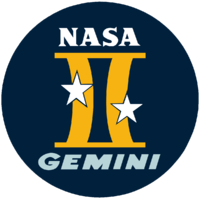Gemini (spacecraft)
 |
|
| Country of origin | United States |
|---|---|
| Responsible organization | NASA |
| Purpose |
|
| Status | completed |
| Program history | |
| Cost | $1.3 billion (1967) |
| Program duration | 1961–1966 |
| First flight | April 8, 1964 |
| First crewed flight | March 23, 1965 |
| Last flight | November 11–15, 1966 |
| Successes | 12 |
| Failures | 0 |
| Partial failures |
2: |
| Launch site(s) | Cape Kennedy Air Force Station LC-19 |
| Vehicle information | |
| Vehicle type | Capsule |
| Crew vehicle | Gemini |
| Crew capacity | 2 |
| Launch vehicle(s) | |
2:
Project Gemini was NASA's second human spaceflight program. It was a United States space program that started in 1961 and concluded in 1966. Project Gemini was conducted between projects Mercury and Apollo. The Gemini spacecraft carried a two-astronaut crew. Ten crews flew low Earth orbit (LEO) missions between 1965 and 1966. It put the United States in the lead during the Cold War Space Race against the Soviet Union.
Its objective was to develop space travel techniques to support Apollo's mission to land astronauts on the Moon. Gemini achieved missions long enough for a trip to the Moon and back, perfected working outside the spacecraft with extra-vehicular activity (EVA), and pioneered the orbital maneuvers necessary to achieve space rendezvous and docking. With these new techniques proven by Gemini, Apollo could pursue its prime mission without doing these fundamental exploratory operations.
All Gemini flights were launched from Launch Complex 19 (LC-19) at Cape Kennedy Air Force Station in Florida. Its launch vehicle was the Gemini–Titan II, a modified Intercontinental Ballistic Missile (ICBM). Gemini was the first program to use the newly built Mission Control Center at the Houston Manned Spacecraft Center for flight control.
...
Wikipedia
